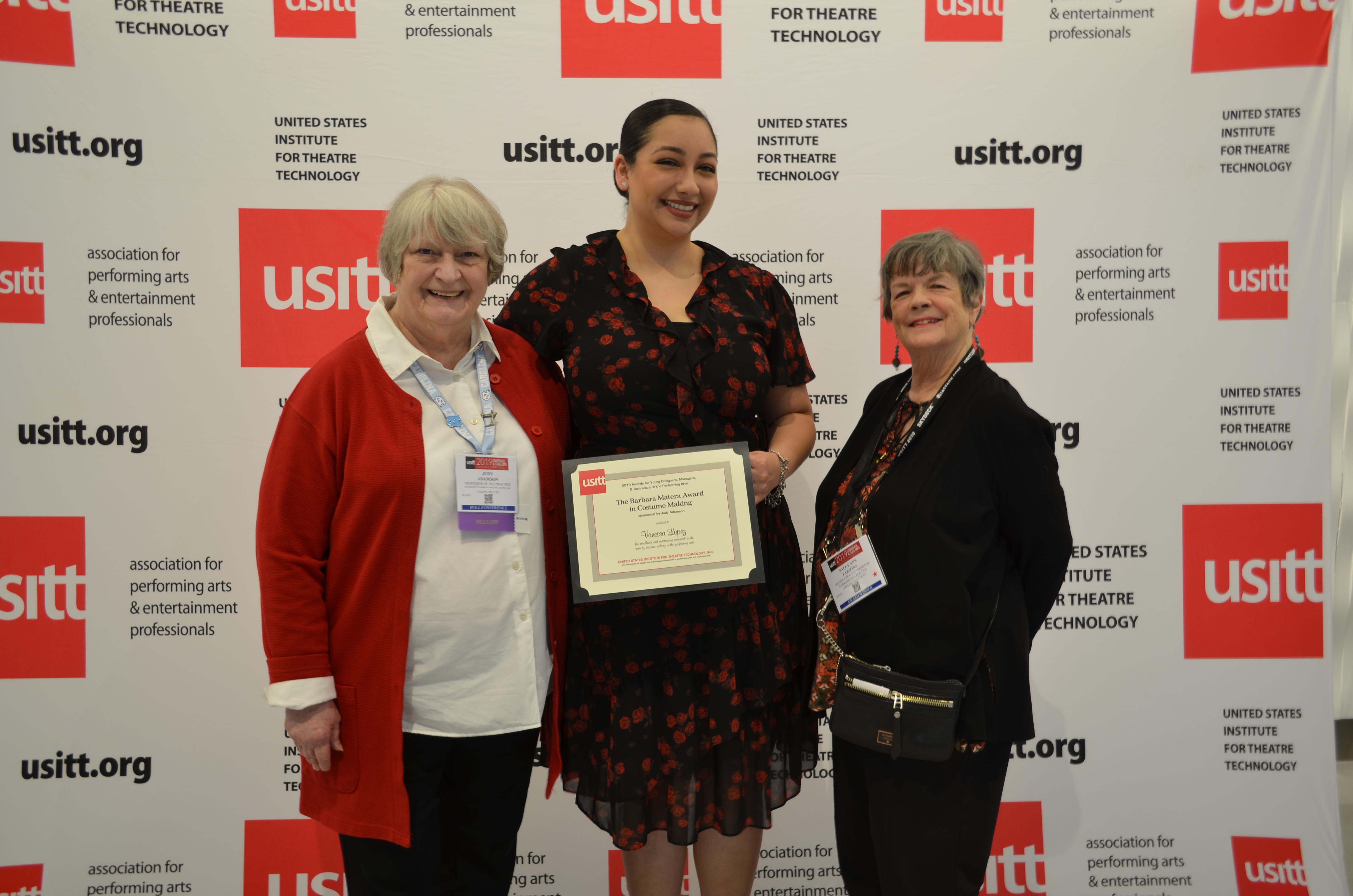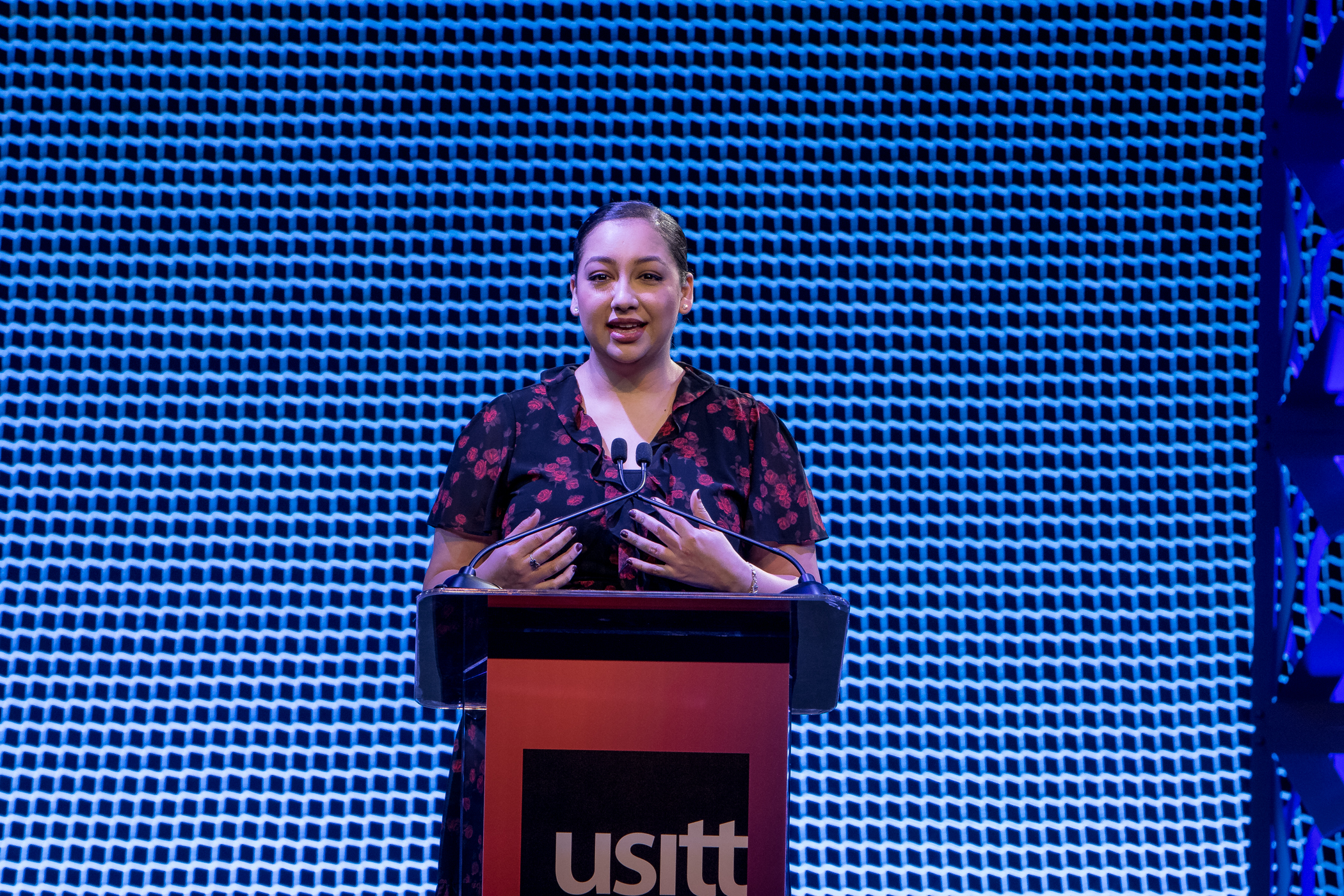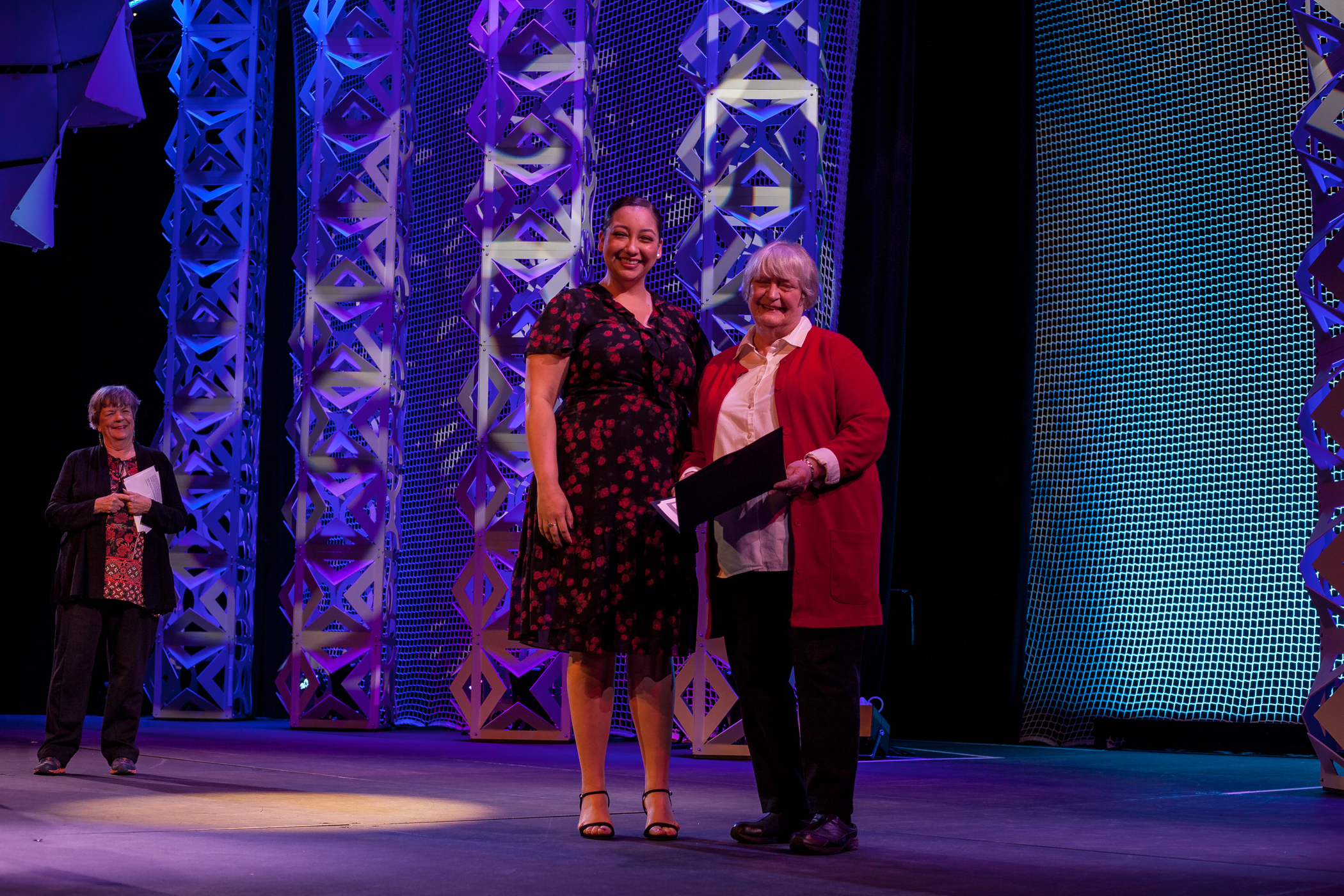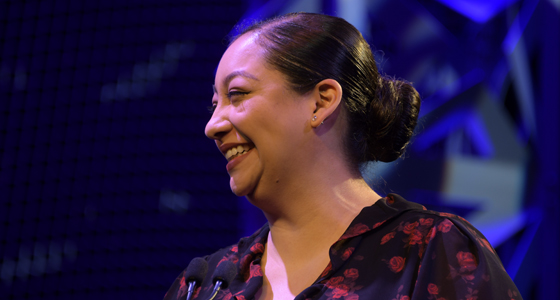Vanessa Lopez left USITT 2019 as the winner of the Barbara Matera Award for Costume-Making, one of the prestigious Young Designers, Managers, and Technicians Awards presented annually to those early in their career. We sat down with Vanessa in Louisville to discuss her win, working as a Hispanic woman in the arts, and how her healthy work/life balance has led her to excel in her career.
Firstly, congratulations! Tell me about the award And how it feels to win
 Oh my goodness. I am on cloud nine right now. So, as you know, this year, I won the Barbara Matera Award for Costume-Making, sponsored by Judy Adamson, and it really, really is humbling and honoring, because I’ve had those moments of imposter syndrome where I feel like, “Do I really belong in this industry,” especially in the culture I came from. I’m a Hispanic woman and was raised to be a homemaker, a mother, and a lover. I went to my family of medical professionals, and said, “I’m going to go do art.”
Oh my goodness. I am on cloud nine right now. So, as you know, this year, I won the Barbara Matera Award for Costume-Making, sponsored by Judy Adamson, and it really, really is humbling and honoring, because I’ve had those moments of imposter syndrome where I feel like, “Do I really belong in this industry,” especially in the culture I came from. I’m a Hispanic woman and was raised to be a homemaker, a mother, and a lover. I went to my family of medical professionals, and said, “I’m going to go do art.”
How did that go over?
Well, it took a minute. You know, everyone’s always worried about financial stability no matter what you do. For some reason, the arts have this reputation and I have no idea why because I found that doing what I love and just being passionate and happy about it has, pretty much, guaranteed me jobs and success and meeting people who are just as fun-loving and successful as I am.
I’m very happy to report that I was able to go back to my family, with all my bills paid on my own and say, “Look, family, I’m doing what I love.” This award is just another thing that reinforces that statement, that doing what you love is guaranteed to take you far in life.
Who have been some of your mentors, along the way?
George Reyes is one of them. He’s the one who first sat me down at a sewing machine and started me on this process. When I was in high school, I was actually going to be an engineering major, and I took theatre as my last-minute blow off class to fulfill my requirements and we were required to make our own costumes for Midsummer. I went to public high school, which doesn’t have massive budgets for the arts, so we were told to either go to GoodWill, borrow, or somehow source your costume, and my little bit of Type A personality said, “No, I want to make something custom.” Fortunately, George knew how to sew, because he had been down this path before.
That’s why I said thank god for art teachers because they really show us things that relate to a lot of our life. He sat me down, and said, “Of course, I’ll teach you how to sew,” and I made my first skirt. In hindsight, it was terribly constructed and all my seams were all over the place. But, that’s what got me hooked, and I went home and said, “I’m gonna do this!” George connected me with Margaret Mitchell, who’s heavily involved in USITT and OISTAT. She’s been, an extended family member and taken me under her wing. She was my primary faculty member in undergrad. She’s also our resident costume designer at Incarnate Word, but she designs all over the country.
So, she became your go-to?
I latched onto her told her, “You are the people I want to surround myself and work with.” She’s been very nurturing and caring. Whenever there have been opportunities, she always approached me, and said, “I need a draper, you want to come work for me?” So, I just finished up a project with her, working for Ballet Idaho. I draped their Primas, so the Sugarplums and the Dew Drop, and that’s going to be opening next year.
Margaret will always be in my life. She connected me with Jim Glaven, who was my graduate school faculty member. He’s another extended member of my family, and that’s what I love about almost every person I’ve ever come across in this industry. They want you to succeed. Everyone is there for each other because if your comrades do well, you do well. You’re like an extension of them. He took all the skills I previously had and turned them up a notch. He’s full of costume technology knowledge. Any question I ask him, he can answer, just like that.
Val Winkleman is someone else I have to acknowledge. We have this sewing hierarchy of “who taught, who taught who.” Val had taught Margaret to sew, back in the day, and when I finally met Val, I said, “Oh, thanks to you, it’s trickled down to me.” She’s become one of my best friends in the world, but she’s also someone I really have to thank for that.
How many years have you attended USITT?
 This is my third time. My first time I came, it was mostly, “Oh, all the techs go to USITT, so let’s go to USITT.” I didn’t really take full advantage of it, and I regret it so much. I pretty much came along just for the trip and wandered around the Expo Floor. After the fact, I went, “Wow, I really want to get involved and talk because these are the people I want to work with. Why didn’t I do that when I was there?”
This is my third time. My first time I came, it was mostly, “Oh, all the techs go to USITT, so let’s go to USITT.” I didn’t really take full advantage of it, and I regret it so much. I pretty much came along just for the trip and wandered around the Expo Floor. After the fact, I went, “Wow, I really want to get involved and talk because these are the people I want to work with. Why didn’t I do that when I was there?”
So, my next year, I applied to be a student volunteer so that I could be in as many rooms, and sit alongside as many people as I could. That’s what I love about USITT. It brings “major” industry people into one place. Not only “major” people, though, but people who love it just as much as you do. I tried to schmooze as much as I could as a student volunteer, even though I was on the clock. At USITT19 I wanted to dive in headfirst, and that’s why I applied for everything from the forums and poster sessions to the awards, I’m trying to make as many networking connections as I can.
How do you find a work-life balance?
It’s a very delicate balance. I have a bit of leeway in the sense that I don’t have children, I don’t have pets, I don’t have a partner. So I don’t have to concern myself with those things. Not to say that they’re not important. One day, I will have to find that balance, but currently, it’s very easy for me to travel and just pick up and leave at any moment.
I do have to force myself to take a break, though, because as technicians, we’re hard-wired to work hard. We’re used to long tech calls. I’ve even had overnight calls before. Not purposely, but because I’m Type A, I want to get the project done and I want to be successful. You have to force yourself to take a moment, and just go have a nice drink. Not necessarily an alcoholic drink, but a coffee at lunch. Sometimes as a reward to myself, I’ll schedule a massage. But, the most important thing I will not sacrifice is my sleep.
I know it’s easy to sacrifice sleep in this industry, but I can’t. If I don’t set sleep into my schedule as a priority, then the rest of my work suffers from it. It’s scheduling that time for yourself, and it’s not an option. You have to schedule in that break.
Tell me about your path so far and how it has led you here
Like I said I ended up in my undergrad major on accident. When I got to undergrad, I got a BA from Incarnate Word and I was required to take all of the courses. A little bit of lighting, a little bit of scenery, and we had to do some acting. I knew from high school, that costumes was my gig. I wanted to be a costumer. We were required to take a practicum course, that said, “You have to be on at least two of the actuation crews, sometime during your career here.” I fought it, tooth and nail, I said, “I just want to do costumes, please don’t make me do anything else!”
But, I did do a little bit of lighting and scenery, and I actually loved it. It gave me an appreciation for what my peers do because now that I’ve been up on an A-Frame, 16 feet in the air, I don’t want to do it again. So, I respect the people who can do it. But, it’s like when I ask my peers about sewing, and they’re like, “Oh, it’s like building with water.” My old technical director used to say that.
I knew costumes were what I wanted to do and I made it very clear to all of my faculty. I’ve been fortunate that every department I’ve been in has been nurturing, and said, “Yes, whatever you want to do, we will support you. We will supply you with whatever you need.”
 Once I graduated from undergrad, the woman who was the Costume Shop Manager while I was a student there happened to leave that same year, so my University said, “Hey, we’ve trained you, you love costuming, and we know you’re passionate about it. Do you want to be our next Shop Supervisor?” I jumped at the opportunity and said, “Yes! Please hire me, right away!” So, I was hired as the Shop Supervisor at Incarnate Word in San Antonio.
Once I graduated from undergrad, the woman who was the Costume Shop Manager while I was a student there happened to leave that same year, so my University said, “Hey, we’ve trained you, you love costuming, and we know you’re passionate about it. Do you want to be our next Shop Supervisor?” I jumped at the opportunity and said, “Yes! Please hire me, right away!” So, I was hired as the Shop Supervisor at Incarnate Word in San Antonio.
I could’ve stayed there the rest of my life and been happy and content. I loved it. I loved my coworkers, I loved the students, and I loved what I did. But there came a time, and a place, where I felt like I wanted to do more and I wanted to expand my knowledge of the craft. I had done a lot of draping and tailoring, previous to that, but I had never experienced millenary, mask-making, and all of the crafts things.
I started doing research into programs around that. Fortunately, I’m from Texas, and right up the freeway was UT Austin, which, in my opinion, has one of the best grad programs in the country. They teach all the aforementioned in one place. I didn’t have to travel to one school for mask-making, one school for tutu-making, etc. I even learned special effects makeup! There were so many things to learn. That’s exactly how Jim Glaven is — an encyclopedia of costume technology knowledge, and I can only hope to be on that level, one day.
I’m about to graduate Grad School* and I have just a fraction of the knowledge that Jim has given me. I mean, I have all the knowledge he’s given me, but I hope to take that out into the world and share what I’ve learned from him at UT Austin.
have you seen a growth in diversity in the industry? What about costuming specifically?
I absolutely have. I am a Hispanic woman and in a lot of places I have worked, particularly in the costume shop, I haven’t seen a lot of Hispanic women, but that’s not to say they’re not there, everyone works just as hard as the next person. Also, the new movement in Drag Culture, and shows like Project Runway, and RuPauls Drag Race just show what people can do when their creativity has sparked an interest. I definitely see it and I definitely feel it. I get approached by some people who have no idea what I do for a living. They say, “Oh, she does fashion design,” or something like that. I tell them it’s a little bit different, but it’s okay because you’re starting the conversation. I’m happy to tell everybody! I’ll tell the stranger on the bus sitting next to me what I do for a living. I’ll pull out my website and say, “Look at what I did!” I love it. This boom in technology has helped as well. Now with 3D printing and laser cutting, the masses can now easily access and utilize it. 3D printing used to sound like some Sci-Fi concept a few years ago. Now it’s like, “No, even costumers, or whoever can use it in their everyday workflow,” so, I think that’s helping with the expansion.
*Since USITT19, Vanessa has graduated from the University of Texas at Austin with her MFA in Costume Technology. She then went on to work on a Robert Rodriguez film, We Can Be Heroes, for Netflix during the summer as a draper. You can now find Vanessa in Minneapolis in her new role of the head craftsperson and fabric dyer at the illustrious Guthrie Theater.
